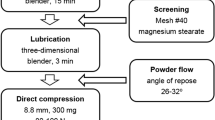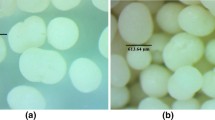Abstract
Polymeric coating materials have been widely used to modify release rate of drug. We compared physical properties and release-controlling efficiency of polymeric coating materials using matrix-type casted film and diffusion-controlled coated tablet. Hydroxypropylmethyl cellulose (HPMC) with low or high viscosity grade, ethylcellulose (EC) and Eudragit® RS100 as pH-independent polymers and Eudragit S100 for enteric coatings were chosen to prepare the casted film and coated tablet. Tensile strength and contact angle of matrix-type casted film were invariably in the decreasing order: EC> Eudragit S100> HPMC 100000> Eudragit RS100>HPMC 4000. There was a strong linear correlation between tensile strength and contact angle of the casted films. In contrast, weight loss (film solubility) of the matrix-type casted films in three release media (gastric, intestinal fluid and water) was invariably in the increasing order: EC < HPMC 100000 < Eudragit RS100 < HPMC 4000 with an exception of Eudragit S100. The order of release rate of matrix-type casted films was EC > HPMC 100000 > Eudragit RS100 > HPMC 4000 > Eudragit S100. Interestingly, diffusion-controlled coated tablet also followed this rank order except Eudragit S100 although release profiles and lag time were highly dependent on the coating levels and type of polymeric coating materials. EC and Eudragit RS100 produced sustained release while HPMC and Eudragit S100 produced pulsed release. No molecular interactions occurred between drug and coating materials using 1H-NMR analysis. The current information on release-controlling power of five different coating materials as matrix carrier or diffusion-controlled film could be applicable in designing oral sustained drug delivery.





Similar content being viewed by others
References
Lee B-J, Ryu S-G, Cui J-H. Controlled release of dual drug-loaded hydroxypropyl methyl cellulose matrix tablet using drug-containing polymeric coatings. Int J Pharm. 1999;188:71–80.
Lecomte F, Siepmann J, Walther M, MacRae RJ, Bodmeier R. Blends of enteric and GIT-insoluble polymers used for film coating: physicochemical characterization and drug release patterns. J Contr Rel. 2003;89:457–71.
Cao Q-R, Choi H-G, Kim D-C, Lee B-J. Release behavior and photo-image of nifedipine tablet coated with high viscosity grade hydroxypropylmethylcellulose: effect of coating conditions. Int J Pharm. 2004;274:107–17.
Sangalli ME, Maroni A, Foppoli A, Zema L, Giordano F, Gazzaniga A. Different HPMC viscosity grades as coating agents for an oral time and /or site-controlled delivery system: a study on process parameters and in vitro performances. Eur J Pharm Sci. 2004;22:469–76.
Cao Q-R, Lee E-S, Choi Y-J, Lee B-J. Rumen bypass and biodistribution of l-carnitine from dual-layered coated pellets in cows, in vitro and in vivo. Int J Pharm. 2008;359:87–93.
Piao Z-Z, Lee M-K, Lee B-J. Colonic release and reduced intestinal tissue damage of coated tablets containing naproxen inclusion complex. Int J Pharm. 2008;350(1–2):205–11.
Siepmann F, Siepmann J, Walther M, MacRae RJ, Bodmeier R. Blends of aqueous polymer dispersions used for pellet coating: importance of the particle size. J Contr Rel. 2005;105:226–39.
Bando H, McGinity JW. Physicochemical properties of enteric films prepared from aqueous dispersions and organic solutions. Int J Pharm. 2006;313:43–8.
Kim T-W, Ji C-W, Shim S-Y, Lee B-J. Modified release of coated sugar spheres using drug-containing polymeric suspensions. Arch Pharm Res. 2007;30(1):124–30.
Heng PWS, Wan LSC, Tan YTF. Relationship between aggregation of HPMC coated spheroids and tackiness/viscosity/additives of the coating formulations. Int J Pharm. 1996;138:57–66.
Koennings S, Berié A, Tessmar J, Blunk T, Goepferich A. Influence of wettability and surface activity on release behavior of hydrophilic substances from lipid matrices. J Contr Rel. 2007;119:173–81.
Shao Q, Rowe RC, York P. Comparison of neurofuzzy logic and decision trees in discovering knowledge from experimental data of an immediate release tablet formulation. Eur J Pharm Sci. 2007;31:129–36.
Shao Q, Rowe RC, York P. Comparison of neurofuzzy logic and neural networks in modelling experimental data of an immediate release tablet formulation. Eur J Pharm Sci. 2006;28(5):394–404.
Sako K, Mizumoto T, Kajiyama A, Ohmura Y. Influence of physical factors in gastrointestinal tract on acetaminophen release from controlled-release tablets in fasted dogs. Int J Pharm. 1996;137:225–32.
Yoo JW, Dharmala K, Lee CH. The physicodynamic properties of mucoadhesive polymeric films developed as female controlled drug delivery system. Int J Pharm. 2006;309:139–45.
Acknowledgments
This work was supported by the Korea Science and Engineering Foundation (KOSEF- R01-2008-000-11777-0), and by a grant of the 2009 Korean Health Technology R&D Project, Ministry for Health, Welfare & Family Affairs, Korea. The authors are grateful to Mr. Kyu-Yeol Nam for his partial contributions to the experiments. We also thank the Central Research Laboratory for the use of the 1H-NMR and the Research Institute of Pharmaceutical Sciences, Kangwon National University for allowing the use of their UV–Vis spectrometer.
Author information
Authors and Affiliations
Corresponding author
Rights and permissions
About this article
Cite this article
Piao, ZZ., Lee, KH., Kim, DJ. et al. Comparison of Release-Controlling Efficiency of Polymeric Coating Materials Using Matrix-type Casted Films and Diffusion-Controlled Coated Tablet. AAPS PharmSciTech 11, 630–636 (2010). https://doi.org/10.1208/s12249-010-9377-0
Received:
Accepted:
Published:
Issue Date:
DOI: https://doi.org/10.1208/s12249-010-9377-0




